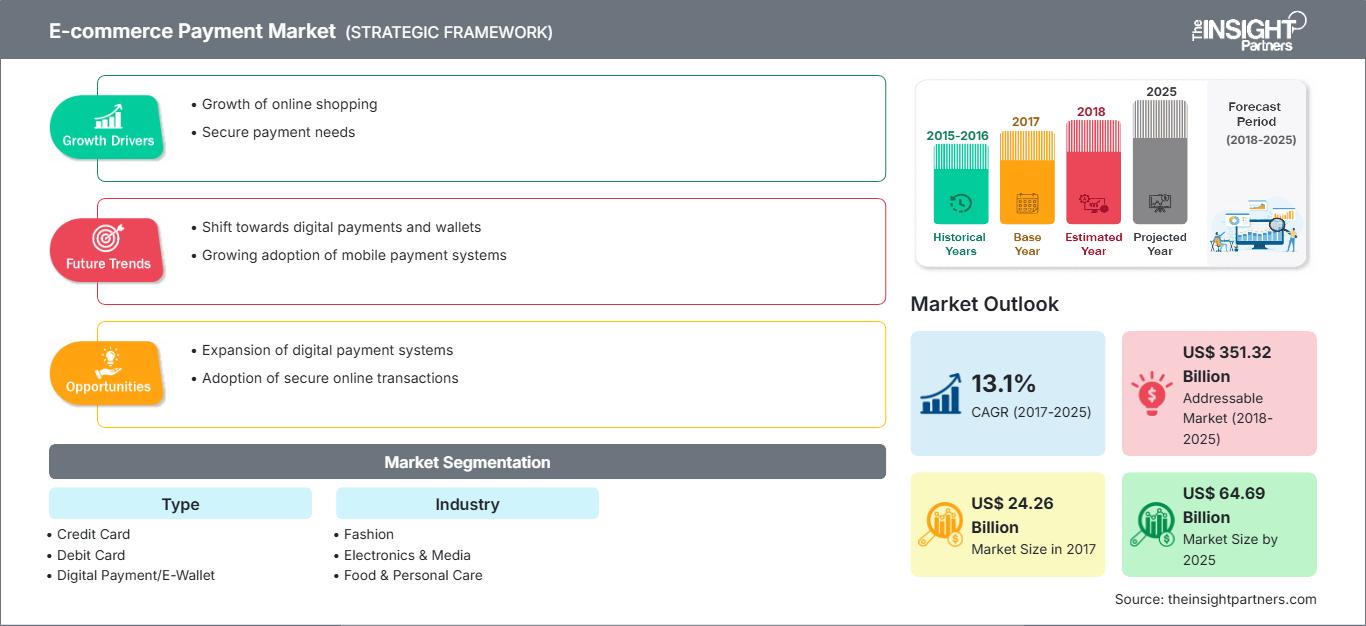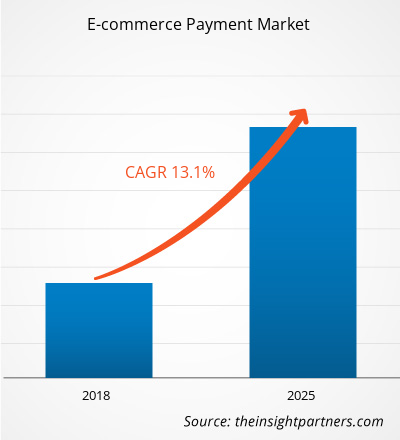Der globale E-Commerce-Zahlungsmarkt soll von 24,26 Mrd. US-Dollar im Jahr 2017 auf 64,69 Mrd. US-Dollar im Jahr 2025 wachsen, was einer durchschnittlichen jährlichen Wachstumsrate (CAGR) von 13,1 % zwischen 2018 und 2025 entspricht.
Der E-Commerce-Zahlungsmarkt wächst weltweit, da Online-Zahlungen aufgrund der Verfügbarkeit verschiedener Zahlungsmethoden immer beliebter werden. Auch die zunehmende Verbreitung von Smartphones und die Verfügbarkeit des Internets treiben das Wachstum des E-Commerce-Zahlungsmarktes voran. Darüber hinaus wird erwartet, dass der E-Commerce-Zahlungsmarkt im Prognosezeitraum aufgrund der steigenden Zahl von Bankkunden und der Digitalisierung florieren wird. Der Bericht konzentriert sich auf eine detaillierte Segmentierung des E-Commerce-Zahlungsmarktes nach Typ, Branche und Geografie.
Markteinblicke
APAC gilt im Prognosezeitraum als führende Region
Der asiatisch-pazifische Raum umfasst mehrere Entwicklungsländer wie Südkorea, Indien, Indonesien und Malaysia. Diese Länder verzeichnen ein starkes Bevölkerungswachstum, was zu einem Wachstum des E-Commerce-Zahlungsmarktes führt. Die E-Commerce-Branche der Region floriert mit der zunehmenden Internetdurchdringung sowie der hohen Nutzung von Smartphones und Tablets. Zudem ergreifen die Regierungen der Schwellenländer Initiativen zur Verbesserung des Bankwesens und bieten so der Online-Zahlungsbranche eine bessere Plattform. In letzter Zeit ist ein Wandel zu beobachten: Verbraucher in der gesamten APAC-Region bevorzugen Online-Zahlungen mit alternativen Zahlungsmethoden wie E-Wallets, Banküberweisungen sowie Kredit- und Debitkarten. Die zunehmende Nutzung dieser Zahlungsmethoden wird im Prognosezeitraum voraussichtlich erheblich zum Wachstum der Zahlungs-Gateways in der E-Commerce-Branche beitragen. Es wird erwartet, dass diese Faktoren die Nachfrage nach E-Commerce-Zahlungsmärkten in der APAC-Region weiter ankurbeln.
Passen Sie diesen Bericht Ihren Anforderungen an
Sie erhalten kostenlos Anpassungen an jedem Bericht, einschließlich Teilen dieses Berichts oder einer Analyse auf Länderebene, eines Excel-Datenpakets sowie tolle Angebote und Rabatte für Start-ups und Universitäten.
E-Commerce-Zahlungsmarkt: Strategische Einblicke

-
Holen Sie sich die wichtigsten Markttrends aus diesem Bericht.Dieses KOSTENLOSE Beispiel umfasst Datenanalysen, die von Markttrends bis hin zu Schätzungen und Prognosen reichen.
Marktinitiativen wurden als die am häufigsten angewandte Strategie im globalen E-Commerce-Zahlungsmarkt beobachtet. Einige der jüngsten Strategien einiger Akteure im E-Commerce-Zahlungsmarkt sind unten aufgeführt:
2018: PayPal gab die Verlängerung seiner Partnerschaftsvereinbarung mit eBay bekannt. Durch diese Vereinbarung fördert und akzeptiert eBay weiterhin PayPal Credit über die Marktplatzplattform.2018: Alipay gab Ende dieses Jahres die Einführung in 20 europäischen Ländern bekannt. Das Unternehmen unterzeichnete Verträge mit über 40 E-Wallet-Anbietern und 100 Banken in ganz Europa.2018: Visa, Inc. gab die Ausweitung seiner Partnerschaft mit PayPal auf Kanada bekannt, um die Implementierung zuverlässiger, sicherer und angemessener mobiler und digitaler Zahlungen für Händler und Verbraucher zu beschleunigen.
Regionale Einblicke in den E-Commerce-Zahlungsmarkt
Die Analysten von The Insight Partners haben die regionalen Trends und Faktoren, die den E-Commerce-Zahlungsmarkt im Prognosezeitraum beeinflussen, ausführlich erläutert. In diesem Abschnitt werden auch die Marktsegmente und die geografische Lage des E-Commerce-Zahlungsmarktes in Nordamerika, Europa, im asiatisch-pazifischen Raum, im Nahen Osten und Afrika sowie in Süd- und Mittelamerika erörtert.
Umfang des Berichts zum E-Commerce-Zahlungsmarkt
| Berichtsattribut | Einzelheiten |
|---|---|
| Marktgröße in 2017 | US$ 24.26 Billion |
| Marktgröße nach 2025 | US$ 64.69 Billion |
| Globale CAGR (2017 - 2025) | 13.1% |
| Historische Daten | 2015-2016 |
| Prognosezeitraum | 2018-2025 |
| Abgedeckte Segmente |
By Typ
|
| Abgedeckte Regionen und Länder |
Nordamerika
|
| Marktführer und wichtige Unternehmensprofile |
|
Dichte der Akteure im E-Commerce-Zahlungsmarkt: Auswirkungen auf die Geschäftsdynamik verstehen
Der Markt für E-Commerce-Zahlungen wächst rasant. Die steigende Nachfrage der Endnutzer ist auf Faktoren wie veränderte Verbraucherpräferenzen, technologische Fortschritte und ein stärkeres Bewusstsein für die Produktvorteile zurückzuführen. Mit der steigenden Nachfrage erweitern Unternehmen ihr Angebot, entwickeln Innovationen, um den Bedürfnissen der Verbraucher gerecht zu werden, und nutzen neue Trends, was das Marktwachstum weiter ankurbelt.

- Holen Sie sich die E-Commerce-Zahlungsmarkt Übersicht der wichtigsten Akteure
Globale Marktsegmentierung für E-Commerce-Zahlungen
Nach Typ
- Kreditkarte
- Debitkarte
- Digitale Zahlung/E-Wallet
- Online-Banking
- Geschenkkarten
- Sonstige
Nach Branche
- Mode
- Elektronik & Medien
- Lebensmittel & Körperpflege
- Möbel und Haushaltsgeräte
- Dienstleistungsbranche
- Sonstige
Nach Geografie
-
Nordamerika
- USA
- Kanada
- Mexiko
-
Europa
- Frankreich
- Deutschland
- Italien
- Spanien
- Großbritannien
- Restliches Europa
-
Asien-Pazifik (APAC)
- Australien
- China
- Indien
- Japan
- Restliches APAC
-
Naher Osten und Afrika (MEA)
- Saudi Arabien
- VAE
- Südafrika
- Rest von MEA
-
Südamerika (SAM)
- Brasilien
- Rest von SAM
Firmenprofile
- PayPal Holdings, Inc.
- Amazon Payments, Inc.
- CCBill, LLC
- WePay Inc.
- Alipay
- Visa, Inc.
- MasterCard Incorporated
- Stripe Inc.
- American Express Company
- UnionPay International Co., Ltd.
- Historische Analyse (2 Jahre), Basisjahr, Prognose (7 Jahre) mit CAGR
- PEST- und SWOT-Analyse
- Marktgröße Wert/Volumen – Global, Regional, Land
- Branchen- und Wettbewerbslandschaft
- Excel-Datensatz
Aktuelle Berichte
Erfahrungsberichte
Grund zum Kauf
- Fundierte Entscheidungsfindung
- Marktdynamik verstehen
- Wettbewerbsanalyse
- Kundeneinblicke
- Marktprognosen
- Risikominimierung
- Strategische Planung
- Investitionsbegründung
- Identifizierung neuer Märkte
- Verbesserung von Marketingstrategien
- Steigerung der Betriebseffizienz
- Anpassung an regulatorische Trends






















 Kostenlose Probe anfordern für - E-Commerce-Zahlungsmarkt
Kostenlose Probe anfordern für - E-Commerce-Zahlungsmarkt